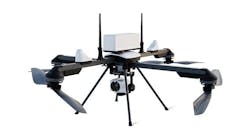It happened again just last month in central Arizona: A recreational drone intruded on efforts to quell a major forest fire.
Authorities immediately suspended fire aviation operations in fear of the drone colliding with a low-flying air tanker. The incident prompted Arizona Gov. Doug Ducey to send a message to drone operators via Twitter.
“Don’t do it!” his tweet said.
Dennis Morton, a forest aviation officer for the U.S. Forest Service, recalls a drone interrupting firefighting efforts during the Lolo Peak Fire in Montana in 2017.
“We shut our airspace down,” he said. The timing was terrible as dusk was approaching, “so when we did get the aircraft back up, we lost a valuable hour of time. We had to set them down pretty quickly because of nightfall.”
As the popularity of piloting drones (also known as unmanned aerial vehicles or UAVs) grows, those working to put out fires on national forest lands worry about the occasional, perhaps inevitable, collision of low-altitude technology and high-stakes efficiency.
As Morton puts it: “It’s on our minds every time we fight a fire.”
Though the National Interagency Fire Center, which collects data on fire-related issues, said there have only been four reported drone incursions in the U.S. this year, the number of incidents over the past five years make firefighters nervous: 16 in 2014, 25 in 2015, 41 in 2016, 36 in 2017 and 28 in 2018.
Most of those affect firefighting operations. Of the 28 incidents in 2018, 23 led to a shutdown in aerial firefighting operations, according to the fire center. Of the 26 in 2017, 26 led to shutdowns, including two in New Mexico — during the Cajete and Bonita fires.
The Federal Aviation Association reports some 900,000 people have registered with the agency to operate one or more drones and estimates about 1.2 million small drones are being flown for noncommercial purposes.
FAA regulations prohibit those drones from flying in restricted areas, like military bases, commercial airports and national forests. FAA rules also prohibit drones from flying above 400 feet in most airspaces, and given that firefighting planes and helicopters often fly that low, a drone weighing some 55 pounds could cause trouble in a collision.
“Aviation is a big part of firefighting,” said Julie Anne Overton, spokeswoman for the Santa Fe National Forest. “And a drone can bring one of those aircraft down. People don’t realize that something that small can cause a crash of one of our aircraft.”
She and other forest officials expressed relief that the number of drone-in-fire incidents has remained low in the first half of 2019. That could be due to increased educational outreach campaigns that the Forest Service, drone organizations and the FAA have been conducting.
The operators of those unauthorized drones, if caught, can face severe financial and civil penalties. But it’s difficult to find them, leaving law enforcement agencies and prosecutors with little to work with when it comes to enforcing the law.
As a result, said Jessica Gardetto, a spokeswoman for the National Interagency Fire Center, few operators are caught or prosecuted.
Morton, currently deployed in New Mexico’s Cibola National Forest for part of the summer, said one drone operator was taken into custody in Montana after he posted photos of the fire that he captured with his drone on social media.
Will Cashen, chairman of the Unmanned Aerial Vehicle Systems Association, a hobbyist advocacy group, said the potential for fines and negative effects on firefighting operations might be playing a role in the recent downturn in drone operations during fires.
He said more people are realizing it’s dangerous.
Cashen added there are at least two reasons why people could be flying their drones during a fire.
“It’s another stimuli, it’s the real video game,” he said. “That could be pretty stimulating to guys who are young and building a drone, and they can show their buddies how they filmed it as the fire was moving down this ridge.”
He said a second, but not nearly as likely, reason could be a drone owner’s curiosity about the fire’s location. He said he foresees water-carrying drones helping in fighting forest fires within the next decade.
Actually, many forest firefighting initiatives include drones, which serve as eyes in the sky above the flames, finding the hottest portions of a wildfire and helping to facilitate digital communication efforts in the field.
Morton said “most if not all firefighting drone flights are at night because we don’t have any other aircraft up there at the time. The airspace is not congested and the drone is free to fly. … They can help our crews with fire detection at night, especially in concurrence with burnout operations. They can bring us right to the fire.”
Despite the potential for using drones to help rather than hinder, some Forest Service personnel remain on edge about the possibility of a worst-case scenario should an unauthorized drone invade firefighting airspace during a blaze.
“The bottom line is, if you fly a drone over a wildfire, you are putting someone else’s life in danger,” said Denise Ottaviano, a spokeswoman for the Carson National Forest.
And Morton said if a drone interrupted an aerial medical evacuation during a fire, “we’d have to do a rapid risk assessment and figure out how critical the situation is … whether we could launch an aircraft to pick up the injured person. And that could cost somebody their life.”
———
©2019 The Santa Fe New Mexican (Santa Fe, N.M.)
Visit The Santa Fe New Mexican (Santa Fe, N.M.) at www.santafenewmexican.com
Distributed by Tribune Content Agency, LLC.

